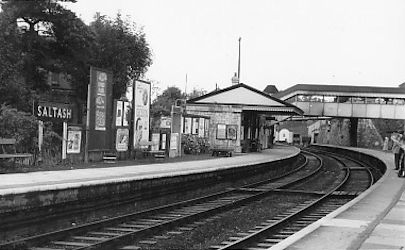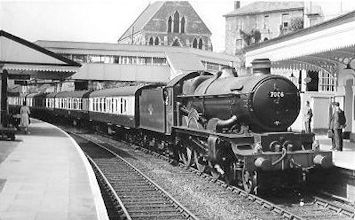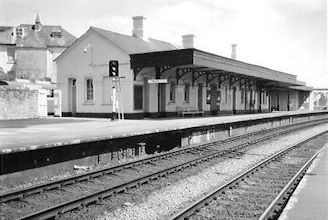|
OLD DEVONPORT
. UK |
||
|
© Brian
Moseley, Plymouth Webpage created: May 28, 2018 Webpage updated: February 01, 2022 |
||
|
RAILWAYS IN OLD DEVONPORT
|
CORNWALL RAILWAY COMPANY SALTASH STATION
The Down platform at Saltash Station. Saltash Station, at 251 miles 26 chains mile post mileage from London Paddington Station via Bristol Temple Meads Station and Plymouth Station (Millbay), was opened by the Cornwall Railway Company on May 4th 1859, when the main line from Plymouth Station (Millbay) to Truro Station was opened. A gods shed was opened in 1863 and the Station was rebuilt in 1880. "The Cornishman" reported on Thursday May 12th 1881 that: 'Our new railway-station will be opened, most probably, this week. It is a very nice structure and a great credit to the town. It ought to have existed, in its present form, many years ago.' Saltash Station was the terminus of the Suburban Service from Plymouth Station (Millbay) and later North Road Plymouth Station although some trips ran on to Defiance Halt, Menheniot, Saint Germans, Liskeard or even Doublebois. That service, begun by the Great Western Railway Company in 1904, ceased under British Rail in May 1972. According to the Great Western Railway Company's official "Traffic Dealt with at Stations and Depots", published circa 1936, in the calendar year 1903 Saltash Station issued 124,272 railway tickets, dealt with 1,226 parcels and took in total income £9,297. Also begun by the Great Western Railway Company's Road Motor Department on June 1st 1904 was a motor bus service from Saltash Station Yard through the village Albaston to Callington. A serious accident occurred at Saltash Station on Monday March 27th 1905, when the engine what was to be the 6.15am workmen's only train collided heavily with its five carriages while changing ends in preparation for its journey to Plymouth Station (Millbay). There were about 200 passengers on the train, or milling about on the Down platform, and the collision was so violent that many were flung around the carriages, banging heads together and causing battered noses. Many injuries were caused by the glass windows smashing and the dislodging of men's dinner baskets from the luggage racks. One man who was smoking a pipe had it broken to pieces in his mouth. Luckily the shunter who should have been stood at the buffers waiting to couple the engine to the train was on this day riding on the engine at the time, otherwise he would certainly have been badly injured. Fortunately the end compartment nearest the point of impact was a guard's van and empty at the time. Injured passengers in need of surgical treatment were swiftly taken to Doctors R T Meadows and G Preston. The train was taken empty into Plymouth and the passengers were transferred to a following train, which departed from Saltash Station at 6.43am. The workmen's ticket cost one shilling per week. In 1906 a new Waiting Room was built and at the end of July 1906 work started on replacing the overbridge at the west end of the Station that carried the road to Coombe over the Railway. Built of stone, it had a span of just 30 feet but the new steel girder bridge would have a span of 41 feet, allowing an extra 10 feet of platform to be constructed on each side of the line. The contractors on the deviation, Messrs Relf and Son, were engaged to make the alterations, under the supervision of Mr W F Fox, the resident engineer of the Great Western Railway Company. A temporary bridge was fixed alongside the old bridge, using two five ton girders, and traffic was diverted over it on August 13th 1906. Then the old bridge arch was stripped clean and on Thursday August 23rd 1906 23 holes were drilled for the explosives. At 6.30am on Sunday August 26th 1906 the Up line was covered with a layer of longitudinal sleepers on edge, with a second layer of cross sleepers, and then another layer of timbers and sleepers, to prevent damage to the railway track from falling masonry. After the 7.40am Plymouth to Penzance train had passed, the Down line was similarly covered along with the platform. This work was finished by 9am. Then the dynamite cartridges were set. In order to prevent the 200 tons of masonry from flying in all directions, the holes were covered with sand, timber and fagots. Watched by Mr T H Gibbons, GWR divisional engineer, Mr T Kateley, of the traffic department, and Mr E Davey, the contractor's foreman, and a large crowd of people, the bridge was then brought crashing to the ground. About thirty men then set to work clearing the debris from the Up line and this was accomplished in time for the 8.30am train from Penzance to pass Saltash Station at its booked time. Down traffic was for a time diverted to the Up line, until that was cleared by 7pm. In addition to the work at the west end of the Station, the approach from the Royal Albert Bridge was also to be altered, requiring the widening of three of the spans. The reason was this was that at the time the "fouling point' where the track of the Up line was less than 6 feet 6 inches from the track of the Down line, was nearly in the middle of the platforms, opposite the bookstall. This meant that stopping trains could not use the entire lengths of the platforms without blocking the opposite line. Once this obstacle was removed the platform lengths would be increased from 300 feet to 400 feet. During the calendar year 1913 Saltash Station issued 429,737 railway tickets, dealt with 1,331 parcels and took in total receipts of £14,573. The calendar year 1923 saw Saltash Station issuing 415,701 railway tickets plus 1,825 season tickets, dealing with 2,622 parcels and taking in total receipts of £25,171. Following the introduction of GWR Road Motor Services from Saltash Station, during the calendar year 1929 it issued 45,925 railway tickets plus 972 season tickets, handled 2,953 parcels and took in total income of £22,265. On Weekdays and Sundays, 'where train service permits', commencing on May 1st 1953, the following cheap day return tickets, first and third class, were available from Saltash Station to: Bickleigh, 4 shillings 1st, 2 shillings (s) 9 pence (d) 3rd; Bittaford Platform, 6s 1st, 4s 3rd; Bodmin General, 9s 1st class, 6s 3rd class; Bodmin Road, 7s 9d 1st, 5s 3d, 3rd; Brent, 7s 1st, 4s 9d 3rd; Clearbrook Halt, 4s 9d 1st, 3s 3d, 3rd; Cornwood, 4s 6d 1st, 3s 3rd; Doublebois, 5s 9d 1st, 3s 9d 3rd; Horrabridge, 5s 9d 1st, 3s 9d 3rd; Ivybridge, 5s 3d 1st, 3s 6d 3rd; Kingsbridge, 11s 1st, 7s 3d 3rd; Liskeard, 4s 9d 1st, 3s 3d 3rd; Looe, 7s 9d 1st, 5s 3d 3rd; Lostwithiel, 9s 1st, 6s 3rd; Lydford, 9s 1st, 6s 3rd; Mary Tavy, 8s 1st 5s 3d 3rd; Menheniot, 3s 9d 1st, 2s 6d 3rd; Plym Bridge Platform, 3s 1st, 2s 3rd; Princetown, 8s 9d 1st, 5s 9d 3rd; Saint Germans, 2s 3d 1st, 1s 5d 3rd; Shaugh Bridge Platform, 4s 6d 1st, 3s 3rd; Tavistock South, 6s 9d 1st, 4s 6d, 3rd; Totnes, 9s 3d 1st, 6s 3d 3rd; Whitchurch Down Platform, 6s 6d 1st, 4s 3d 3rd; Wranagton, 6s 6d 1st, 4s 3d 3rd; and Yelverton, 5s 3d 1st, 3s 6d 3rd. One has to wonder why Dousland, Burrator and Sheepstor Halt, Ingra Tor Halt and King Tor Halt were omitted from this offer. According to the "The Official Hand-book of Station 1956" Saltash Station dealt with goods traffic, passengers, parcels, miscellaneous traffic, furniture vans, carriages, motor cars, portable engines and machines on wheels, live stock, horse boxes, prize cattle vans, and carriages and motor cars by passenger or parcels trains. It was equipped with a crane capable of lifting 2 tons.
Even the Up Cornish Riviera Express, hauled by
number 7006, The forecourt of Saltash Station was the starting point of many motor bus services operated by the Western National Omnibus Company Limited. In 1956 the services were: routes 72 to Looe (seasonal service); 75 to Tideford Post Office and extended on Thursdays, Saturdays and Sundays to Saint Ive Post Office; 76 to Callington Fore Street, 180 to Callington Fore Street and extended on Saturdays to Upton Cross; 196 on Tuesdays and Saturdays to Cargreen; and 198 to Forder. On April 29th 1954 a plaque was unveiled on the Station by the Mayor of Saltash, Councillor Eric Lewis, commemorating the 125th Anniversary of the opening of the Royal Albert Bridge by the Prince Consort on May 2nd 1859. Traffic declined rapidly after the Tamar Road Bridge was opened in 1962 and the motor bus services diverted in to Plymouth Bretonside Bus Station. Saltash Station was closed to goods traffic by British Railways on and as from Monday September 9th 1963. It became a partially unstaffed Station on and as from Monday October 11th 1971.
Saltash Station devoid of all its facilities,
including the signal box. The Goods Shed and adjoining siding, along with the crossover and the access crossover from the Down main line to the Up Loop, were all taken out of use in October 1972. This meant that the Up Loop became an Up Refuge Siding. Saltash Signal Box closed on and from Monday July 2nd 1973 and a Ground Frame was brought into operation to operate the points at the Up Refuge Siding. Once such a busy railway station, Saltash is now merely a Halt but at least it is still open.
|
||


